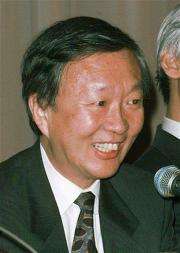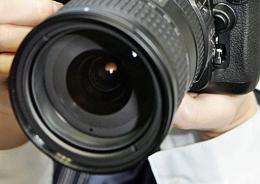'Masters of light' win Nobel Physics Prize

Charles Kao, Willard Boyle and George Smith won the 2009 Nobel Physics Prize Tuesday for pioneering "masters of light" work on fibre optics and semiconductors, the Nobel jury said.
The Hong Kong-based expert Kao and his two American counterparts were hailed for creating the two tools that helped unleash the Information Technology revolution of today.
"This year's Nobel Prize in Physics is awarded for two scientific achievements that have helped to shape the foundations of today's networked societies.
"They have created many practical innovations for everyday life and provided new tools for scientific exploration," it said.
One of them is the fibre-optic cable, which enables transmission of data at the speed of light, the Nobel jury said.
Kao, who has British nationality but has been based in Hong Kong, was awarded half of the prize for "groundbreaking achievements concerning the transmission of light in fibers for optical communication," it said.
"If we were to unravel all of the glass fibres that wind around the globe, we would get a single thread over one billion kilometres (600 million miles) long -- which is enough to encircle the globe more than 25,000 times -- and is increasing by thousands of kilometres (miles) every hour," it said.
Kao's discovery means that "text, music, images and video can be transferred around the globe in a split second," the jury said.
Boyle and Smith shared the other half of the prize for "the invention of an imaging semiconductor circuit -- the CCD sensor," or the charge-coupled device, which is the "electronic eye" of the digital camera.
The CCD sensor, invented in 1969, "revolutioniseded photography, as light could be now captured electronically instead of on film."
CCD technology is also used in many medical applications, such as imaging the inside of the human body, both for diagnostics and for microsurgery.
Last year, the prize went to Makoto Kobayashi and Toshihide Maskawa of Japan and Yoichiro Nambu of the United States for groundbreaking theoretical work on fundamental particles called quarks.
On Monday, Australian-American scientist Elizabeth Blackburn and Carol Greider and Jack Szostak of the United States won the Nobel Medicine Prize for identifying a key molecular switch in cellular ageing.
The Chemistry Prize laureates will be named on Wednesday, followed by the Literature Prize on Thursday and the Peace Prize on Friday. The Economics Prize will wrap up the awards on Monday, October 12.
The Nobel prizes, founded by Swedish industrialist Alfred Nobel, were first awarded in 1901.
Nobel, the inventor of dynamite, died childless in 1896, dedicating his vast fortune to create "prizes to those who, during the preceding year, shall have conferred the greatest benefit on mankind."
Laureates receive a gold medal, a diploma and 10 million Swedish kronor (1.42 million dollars, 980,000 euros) which can be split between up to three winners per prize.
The formal awarding of the prizes will take place at gala ceremonies in Stockholm and Oslo on December 10.
More information: Scientific Background (pdf)
Popular science
• Smith, G.E. (2009) The invention and early history of the CCD. Nuclear Instruments and Methods in Physics Research A, 607, p. 1-6.
• Janesick, J.R. (2002) Duelling Detectors. SPIE's oemagazine, February, p. 30-33.
• Janesick, J.R. (2001) Scientific Charge-Coupled Devices. SPIE Press Monograph, Vol. PM83.
• Hecht, J. (1991) City of Light: The Story of Fiber Optics. Oxford University Press.
• Su, F. (1990) Technology of our times: people and innovation in optics and optoelectronics. SPIE Press, p. 80-95.
Scientfic articles
• Kao, C.K. , Hockham, G.A. (1966) Dielectric-fibre Surface Waveguides for Optical Frequencies. Proceedings of the Institution of Electrical Engineers-London 113, p. 1151.
• Boyle, W.S., Smith, G.E. (1970) Charge Couple Semiconductor Devices. Bell System Technical Journal 49, p. 587.
Born to be wired: Why we love the IT revolutionaries
by Richard Ingham
Remember what it was like, a dozen years or so ago, when you tried to communicate with someone on the other side of the world?
The truncated conversations down crackly copper wires? The chore of sending papers or pictures by post -- by "snail mail"? The insane costs of long-distance contact of almost any kind?
It's no surprise why we have embraced digital technology with such passion, why we have leapt to Internet and email without even a backward glance.
Today, letters, documents and images are dispatched instantly, flawlessly and for free to a recipient thousands of kilometres (miles) away, and phone calls cost just a tiny fraction of what they did in the past.
Physicists Charles Kao, Willard Boyle and George Smith won the Nobel Prize on Tuesday for their part in what many see as a revolution of the mind, changing perspectives about geography and human relationships, as much as it is a revolution of technology.
Kao won half the prize for realising the potential of optical fibres, whose cables now girdle the Earth on the sea floor and across land, delivering data by laser pulse through glass strands.
Boyle and Smith shared a quarter each of the coveted prize for inventing the charge-coupled device (CCD), a semiconductor sensor that converts light into electrical signals, in 1969.
It became the "electronic eye" of the digital camera, used not only by happy-snapping holidaymakers, but also by doctors to get images inside the human body for microsurgery, and by space probes, to get pictures of Saturn and other planets.
"It's taken 30 years [for Nobel recognition], but the importance of these two technologies is obvious," said Phillip Schewe of the American Institute of Physics.
"Ours is the age of information and images, and no two things better symbolise this than the Internet and digital cameras," said Robert Kirby-Harris, chief executive at the Institute of Physics (IOP) in London.
"From kilobytes to gigabytes, and now to petabytes and exabytes, information has never been so free-flowing or, with the development of CCD, so instantly visual.
"These incredible inventors who have been responsible for transforming the world in which we live very much deserve their prize."
The idea of using glass tubes to transmit information dates back to the 1920, with experiments to send images through thin fibres.
But the outcome was disappointing. Whenever the tubes touched, or their surface was scratched, the light "leaked" away.
In 1966, Kao, a young Shanghai-born engineer working at the Standard Telecommunication Laboratories (STL) in Harlow, near London, determined that the main problem lay with iron ions in the glass, which absorbed and scattered the light.
His solution was fused silica, a glass-making process that would be without the impurities.
The difficulty, though, was that fused silica has a highly melting point, and it was tough to make and manipulate such materials on a commercial scale.
Four years afterward, the technical breakthrough came at Corning Glass Works in the United States.
Optical fibre was born, and has been continuously improved since then, thanks to chemical "doping" in the manufacturing process to help mitigate light loss.
Today, a pulse sent down a modern optical fibre loses less than five percent of its light after one kilometre (five-eighths of a mile).
The first transatlantic fibre-optic was installed in 1988, but the real bounty of this technology started to be realised in the late Nineties, when cheap lasers, light repeaters and computing power to handle large packets of data became available.
Kao was "a revolutionary," said Sir Peter Knight, senior principal at Imperial College London.
"He had already spotted the communications opportunities, and therefore the great distances light could travel, while others were still thinking in metres (yards)."

The day Boyle and Smith invented the CCD sensor
The CCD sensor, the digital camera's "electronic eye" which earned inventors Willard Boyle and George Smith the Nobel Physics Prize on Tuesday, was drawn up in a few hours in October 1969.
It was 8:30 am, 40 years ago, and Willard Boyle was sitting in his office at Bell Laboratories in the US state of New Jersey. The videophone rang, and it was Jack Morton, Boyle's boss, according to an account on the Canadian website www.science.ca cited by the Nobel committee.
"What are you semiconductor guys doing? The heck with transistors. Try and come up with something different. I'll call tomorrow."
After lunch, Boyle was joined by his colleague George Smith, and together they worked on "an idea for handling little pockets of charge in a silicon matrix," the website explained.
The pair "fiddled with some math and drew some sketches on the blackboard," with Boyle declaring: "Okay, this looks pretty good," after about an hour and a half of brainstorming.
"We should name it something," suggested Smith.
"Well, we've got a new device here. It's not a transistor, it's something different," replied Boyle.
"It's got a charge. And we're moving the charge around by coupling potential wells," said Smith.
"Let's call it a charge coupled device," said Boyle.
"Sure,'CCD'. That's got a nice ring to it," Smith agreed.
The CCD was at that point only a theory, explained the website, which was quoted in the Royal Swedish Academy of Sciences' press release announcing Tuesday's Nobel laureates in physics.
Boyle and Smith decided to take their invention one step further, and took the plans to the workshop down the hall to see if the CCD could be made.
"Some months later it was made, and it worked exactly as expected," the website said, noting that CCDs can, in addition to their use as image sensors, be used as computer memory, electronic filters and signal processors.
"As imaging devices, they have revolutionised astronomy; virtually every large telescope... uses CCDs because they are about 100 times more sensitive than photographic film and work across a much broader spectrum of wavelengths of light," said the website, run by a non-profit society based in western Canada.
(c) 2009 AFP
















